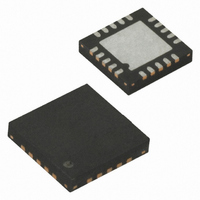ATTINY84-20MU Atmel, ATTINY84-20MU Datasheet - Page 94

ATTINY84-20MU
Manufacturer Part Number
ATTINY84-20MU
Description
IC MCU AVR 8K FLASH 20MHZ 20-QFN
Manufacturer
Atmel
Series
AVR® ATtinyr
Specifications of ATTINY84-20MU
Core Processor
AVR
Core Size
8-Bit
Speed
20MHz
Connectivity
USI
Peripherals
Brown-out Detect/Reset, POR, PWM, Temp Sensor, WDT
Number Of I /o
12
Program Memory Size
8KB (4K x 16)
Program Memory Type
FLASH
Eeprom Size
512 x 8
Ram Size
512 x 8
Voltage - Supply (vcc/vdd)
2.7 V ~ 5.5 V
Data Converters
A/D 8x10b
Oscillator Type
Internal
Operating Temperature
-40°C ~ 85°C
Package / Case
20-MLF®, QFN
Cpu Family
ATtiny
Device Core
AVR
Device Core Size
8b
Frequency (max)
20MHz
Interface Type
SPI/USI
Total Internal Ram Size
512Byte
# I/os (max)
12
Number Of Timers - General Purpose
2
Operating Supply Voltage (typ)
3.3/5V
Operating Supply Voltage (max)
5.5V
Operating Supply Voltage (min)
2.7V
On-chip Adc
8-chx10-bit
Instruction Set Architecture
RISC
Operating Temp Range
-40C to 85C
Operating Temperature Classification
Industrial
Mounting
Surface Mount
Pin Count
20
Package Type
MLF
Processor Series
ATTINY8x
Core
AVR8
Data Bus Width
8 bit
Data Ram Size
512 B
Maximum Clock Frequency
20 MHz
Number Of Programmable I/os
12
Number Of Timers
2
Operating Supply Voltage
2.7 V to 5.5 V
Maximum Operating Temperature
+ 85 C
Mounting Style
SMD/SMT
3rd Party Development Tools
EWAVR, EWAVR-BL
Development Tools By Supplier
ATAVRDRAGON, ATSTK500, ATSTK600, ATAVRISP2, ATAVRONEKIT
Minimum Operating Temperature
- 40 C
Package
20MLF
Family Name
ATtiny
Maximum Speed
20 MHz
For Use With
ATSTK600 - DEV KIT FOR AVR/AVR32770-1007 - ISP 4PORT ATMEL AVR MCU SPI/JTAGATAVRISP2 - PROGRAMMER AVR IN SYSTEM
Lead Free Status / RoHS Status
Lead free / RoHS Compliant
Available stocks
Company
Part Number
Manufacturer
Quantity
Price
12.6.1
12.6.2
12.6.3
12.7
94
Compare Match Output Unit
ATtiny24/44/84
Force Output Compare
Compare Match Blocking by TCNT1 Write
Using the Output Compare Unit
ister since the compare of all 16 bits is done continuously. The high byte (OCR1xH) has to be
written first. When the high byte I/O location is written by the CPU, the TEMP Register will be
updated by the value written. Then when the low byte (OCR1xL) is written to the lower eight bits,
the high byte will be copied into the upper 8-bits of either the OCR1x buffer or OCR1x Compare
Register in the same system clock cycle.
For more information of how to access the 16-bit registers refer to
on page
In non-PWM Waveform Generation modes, the match output of the comparator can be forced by
writing a one to the Force Output Compare (1x) bit. Forcing compare match will not set the
OCF1x flag or reload/clear the timer, but the OC1x pin will be updated as if a real compare
match had occurred (the COM11:0 bits settings define whether the OC1x pin is set, cleared or
toggled).
All CPU writes to the TCNT1 Register will block any compare match that occurs in the next timer
clock cycle, even when the timer is stopped. This feature allows OCR1x to be initialized to the
same value as TCNT1 without triggering an interrupt when the Timer/Counter clock is enabled.
Since writing TCNT1 in any mode of operation will block all compare matches for one timer clock
cycle, there are risks involved when changing TCNT1 when using any of the Output Compare
channels, independent of whether the Timer/Counter is running or not. If the value written to
TCNT1 equals the OCR1x value, the compare match will be missed, resulting in incorrect wave-
form generation. Do not write the TCNT1 equal to TOP in PWM modes with variable TOP
values. The compare match for the TOP will be ignored and the counter will continue to 0xFFFF.
Similarly, do not write the TCNT1 value equal to BOTTOM when the counter is downcounting.
The setup of the OC1x should be performed before setting the Data Direction Register for the
port pin to output. The easiest way of setting the OC1x value is to use the Force Output Com-
pare (1x) strobe bits in Normal mode. The OC1x Register keeps its value even when changing
between Waveform Generation modes.
Be aware that the COM1x1:0 bits are not double buffered together with the compare value.
Changing the COM1x1:0 bits will take effect immediately.
The Compare Output Mode (COM1x1:0) bits have two functions. The Waveform Generator uses
the COM1x1:0 bits for defining the Output Compare (OC1x) state at the next compare match.
Secondly the COM1x1:0 bits control the OC1x pin output source.
a simplified schematic of the logic affected by the COM1x1:0 bit setting. The I/O Registers, I/O
bits, and I/O pins in the figure are shown in bold. Only the parts of the general I/O port control
registers (DDR and PORT) that are affected by the COM1x1:0 bits are shown. When referring to
the OC1x state, the reference is for the internal OC1x Register, not the OC1x pin. If a system
reset occur, the OC1x Register is reset to “0”.
105.
Figure 12-5 on page 95
“Accessing 16-bit Registers”
8006K–AVR–10/10
shows


















